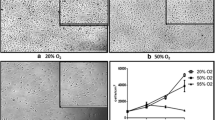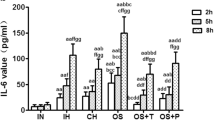Summary
To determine what biochemical indexes might be useful in measuring the endothelial response to hyperoxia in vitro we exposed endothelial cell monolayers (ECM) from pig aortas to either hyperoxic (95% O2:5% CO2, 1 atm) or control conditions (95% air: 5% CO2) and made of following measurements: (a) DNA and protein contents remaining in the ECM; (b) lactate dehydrogenase (LDH) activity in the medium; (c) the net uptake of rubidium (Rb+) adenine, and adenosine; and (d) cellular ATP and medium lactate.
Twelve hours of hyperoxic exposure did not cause significant changes. After 24 or 48 h of hyperoxia, DNA and protein contents were decreased; LDH activity and the protein-to-DNA ratio were increased; adenosine uptake was decreased per ECM but was unchanged when corrected for culture DNA and protein content. Adenine uptake was un-altered as were cellular ATP content and medium lactate concentration. The net Rb+ uptake-to-DNA ratio was increased after 24 h but not after 48 h of hyperoxia. The extent of the DNA and LDH changes indicated that the cellular disturbance caused by hyperoxia was progressive from 12 to 48 h.
Presence of superoxide dismutase (250 U/ml) prevented both the increase of LDH activity and the decrease of protein after 48 h but did not affect the decrease of DNA. These results suggest that the cells remaining in the ECM after hyperoxia have normal biochemical function and may represent a subpopulation of cells more resistant to oxygen toxicity than the damaged cells.
Similar content being viewed by others
References
Kistler, G. S.; Caldwell, P. R. B.; Weibel, E. R. Development of fine structural damage of alveolar and capillary lining cells in oxygen-poisoned rat lungs. J. Cell Biol. 32: 605–628; 1967.
Kapanci, Y.; Weibel, E. R.; Kaplan, H. P.; Robinson, F. R. Pathogenesis and reversibility of pulmonary lesions of oxygen toxicity in monkeys. II. Ultrastructural and morphometric studies. Lab. Invest. 20: 101–118; 1969.
Block, E. R.; Fisher, A. B. Depression of serotonin clearance by rat lungs during oxygen exposure. J. Appl. Physiol. 42: 33–38; 1977.
Jaffe, E. A.; Nachman, R. L.; Becker, C. G.; Minick, R. Culture of human endothelial cells derived from umbilical veins: identification by morphologic and immunologic criteria. J. Clin. Invest. 52: 2745–2756; 1973.
Junod, A. F.; Ody, C. Amine uptake and metabolism by endothelium of pig pulmonary artery and aorta. Am. J. Physiol. 232: C88-C94; 1977.
Block, E. R.; Stalcup, S. A. Depression of serotonin uptake by cultured endothelial cells exposed to high O2 tension. J. Appl. Physiol. 50: 1212–1219; 1981.
Shepro, E.; Batbouta, J. C.; Roblee, L. S.; Carson, M. P.; Belemarich, F. A. Serotonin transport by cultured bovine aortic endothelium. Circ. Res. 36: 799–806; 1975.
Rubin, D. B.; Housset, B.; Junod, A. F. Purine and serotonin uptakes are not sensitive indicators of hyperoxic injury to endothelial cells in vitro. Am. Rev. Respir. Dis. 123(2): 217; 1981.
DeBono, D. P.; McIntyre, D. E.; White, D. J. G.; Gordon, J. L. Endothelial adenine uptake as an assay for cell or complement-mediated cytotoxicity. Immunology 32: 221–226; 1977.
Underwood, E. J. Trace elements in human and animal nutrition. New York: Academic Press; 1977; 442–443.
Dunham, P. B.; Hoffman, F. F. Na and K transport in red blood cells. Andreoli, T. E.; Hoffman, J. F.; Fanestil, D. D. eds. Physiology of membrane disorders. New York: Plenum Medical Book Co.; 1978; 225–272.
Block, E. R.; Fisher, A. B. Prevention of hyperoxic-induced depression of pulmonary serotonin clearance by pre-treatment with superoxide dismutase. Am. Rev. Respir. Dis. 116: 441–447; 1977.
Dieterle, Y.; Ody, C.; Ehrensberger, A.; Stalder, H.; Junod, A. F. Metabolism and uptake of adenosine triphosphate and adenosine by porcine aortic and pulmonary endothelial cells and fibroblasts in culture. Circ. Res. 42: 869–876; 1978.
Gimbrone, M. A., Jr. Culture of vascular endothelium. Spaet, T. J. ed. Progress in hemostasis and thrombosis. New York: Grune and Stratton; 1976: 1–28.
Randerath, K. Nucleic acid constituents and nucleotide coenzymes. Thin layer chromatography. New York: Verlag Chemie, Academic Press; 1963: 220–225.
Randerath, K.; Randerath, E. Ion-exchange chromatography of nucleotides on poly-(ethyleneimine)-cellulose thin layers. J. Chromatogr. 16: 111–125; 1964.
Bergmeyer, H. U.; Bernt, E.; Hess, B. Lactic dehydrogenase. Bergmeyer, H. U., ed. Methods of enzymatic analysis. New York: Verlag Chemie, Academic Press; 1965: 736–741.
Wroblewski, F.; LaDue, J. S. LDH activity in blood. Proc. Soc. Exp. Biol. Med. 90: 210–213; 1955.
Marbach, E. P.; Weil, M. H. Rapid enzymatic measurement of blood lactate and pyruvate. Use and significance of metaphosphoric acid as a common precipitant. Clin. Chem. 13: 314–325; 1967.
Stanley, P. E.; Williams, S. G. Use of the liquid scintillation spectrometer for determining adenosine triphosphate by the luciferase enzyme. Anal. Biochem. 29: 381–392; 1969.
Setaro, F.; Morley, C. G. D. A modified fluorometric metric method for the determination of microgram quantities of DNA from cells of tissue cultures. Anal. Biochem. 71: 313–317; 1976.
Lowry, O. H.; Rosebrough, N. J.; Farr, A. L.; Randall, R. J. Protein measurement with the folin phenol reagent. J. Biol. Chem. 193: 265–275; 1951.
Zar, J. H. Biostatistical analysis. Englewood Cliffs, N. J.: Prentice Hall, Inc.; 1974: 121–124, 131–144, 151–159, 163–170.
Acosta, D.; Li, C. P. Injury to primary cultures of rat heart endothelial cells by hypoxia and glucose deprivation. In Vitro 15: 929–934; 1979.
Voisin, C.; Aerts, C.; Tonnel, A. B.; Dutriez, N. Aerocontaminants gazeux et defense phagocytaire de l'appareil respiratoire. Nouv. Presse Med. 8: 2089–2094; 1976.
Balin, A. K.; Goodman, D. B. P.; Rasmussen, H.; Cristofalo, V. J. The effect of oxygen tension on the growth and metabolism in WI-38 cells. J. Cell Physiol. 89: 235–250; 1976.
Brosemer, R. W.; Rutter, W. J. The effect of oxygen tension on the growth and metabolism of a mammalian cell. Exp. Cell Res. 25: 101–113; 1961.
Mustafa, M. G.; Tierney, D. F. Biochemical and metabolic changes in the lung with oxygen, ozone and nitrogen dioxide toxicity (state of the art). Am. Rev. Respir. Dis. 118: 1061–1090; 1978.
Lum, C. T.; Marz, R.; Plagemann, P. G. W.; Wohlhueter, R. M. Adenosine transport and metabolism in mouse leukemia cells and in canine thymocytes and peripheral blood leukocytes. J. Cell Physiol. 101: 173–200; 1979.
Lubin, M. Intracellular potassium and macromolecular synthesis in mammalian cells. Nature 213: 451–453; 1967.
Kimelberg, H. K.; Mayhew, E. Increased ousbainsensitive86Rb+ uptake and sodium and potassium ion-activated adenosine triphosphate activity in transformed cell lines. J. Biol. Chem. 250: 100–104; 1975.
Suttorp, N.; Simon, L. M. Lung cell oxidant injury—enhancement of polymorphonuclear leukocyte-mediated cytotoxicity in lung cells exposed to sustained in vitro hyperoxia. J. Clin. Invest. 70: 342–350; 1982.
Author information
Authors and Affiliations
Additional information
This investigation was supported by Swiss National Science Foundation Grant 3.224.077 and by National Institutes of Health Grant HL00310-01.
Rights and permissions
About this article
Cite this article
Rubin, D.B., Housset, B., Jean-Mairet, Y. et al. Effects of hyperoxia on biochemical indexes of pig aortic endothelial function. In Vitro 19, 625–634 (1983). https://doi.org/10.1007/BF02619576
Received:
Accepted:
Issue Date:
DOI: https://doi.org/10.1007/BF02619576




